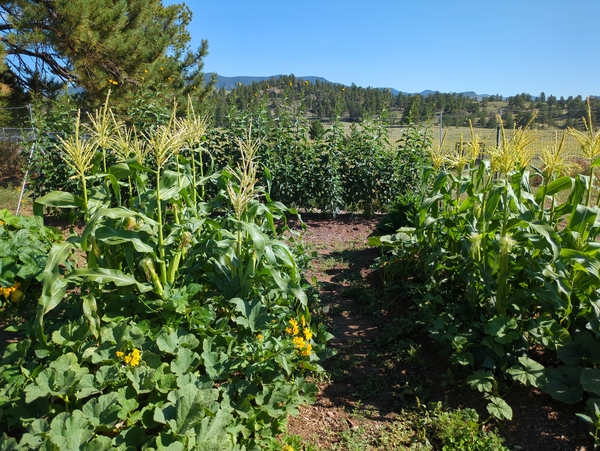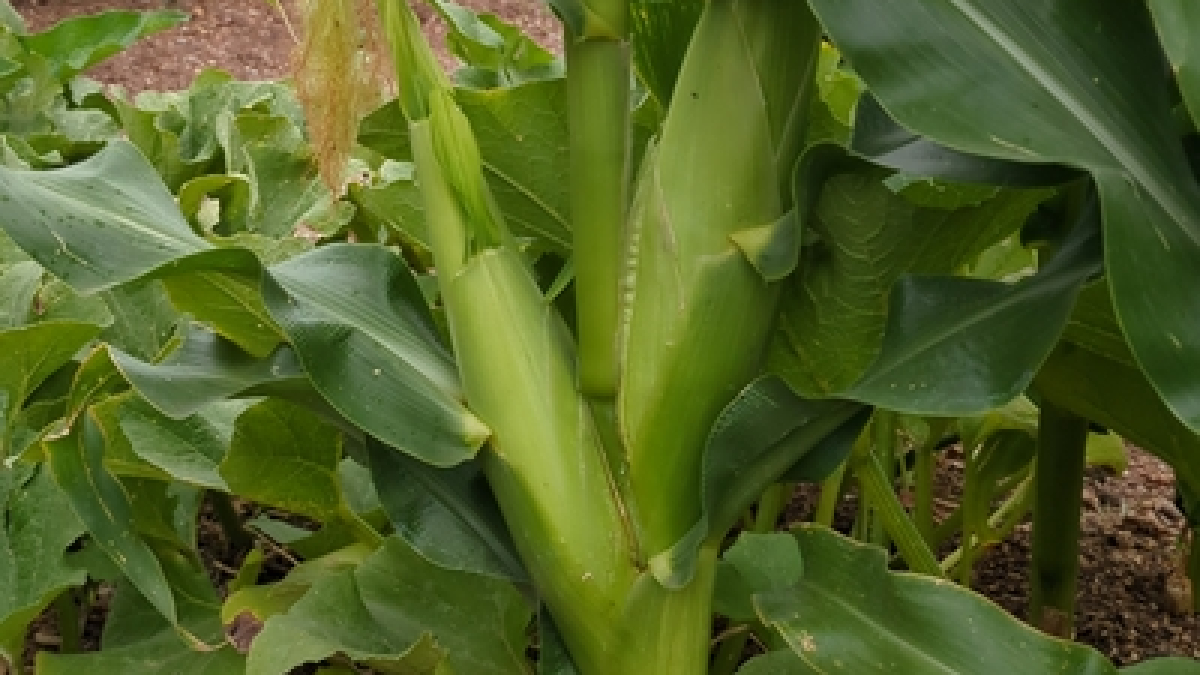CORN @ HIGH ELEVATION
2025 UPDATE
Below was my original post about my attempt (2017) to grow corn here at 9,000 feet. It did not do well, and I never tried it again. Until now.
2025: I have heard of other people growing corn successfully not too far from here, so this year I tried it one more time. Here were my reasons:
- Every year is different. It is possible that my first trial just wasn’t a good year for corn.
- This is my 9th year gardening here in the Rockies. I have a lot more experience under my belt, and a better feel for gardening in general.
- The first year’s trial was done in one of our raised beds topped with hoops & shade cloth. I was therefore forced to choose a short variety. Perhaps that variety wasn’t right for this climate. (See below.)
- Since I only tried that corn in ONE of our raised beds, there wasn’t much of it, and perhaps not enough for it to pollinate each other well. There also weren’t many pollinators around that first year–they have increased along with our consistent garden.
- We now have a fenced outdoor area in the ground for growing, primarily intended for squash. Since I have no vertical space requirements in that area, I can now choose from many more varieties.
- I was reminded of the “three sisters” method of growing squash, corn & beans together. In the new garden space I have room to attempt this combination.
The variety I decided to grow is “Ignition”. It’s bred to be an early variety, so I’d hoped there would be enough time during our short summer to get a harvest of corn.
2025 :: THE RESULTS

I started the corn indoors in soil blocks before transplanting them outdoors about 10 days later. I planted 24 stalks of corn, with the winter squash and some pole beans. The corn seemed to grow pretty well, and for a while I had hopes we could get a nice harvest. When it came down to it, I think that if we’d had another 2 weeks of good weather with no freezing nights, we could have some nice corn.
As it was, the corn stalks grew to about 5′ tall and all had ears that grew somewhat normally, however more slowly than they should, or would in a warmer climate. Our days are plenty warm and the corn got plenty of water with the rain & hose, but I believe our nights are just too cool.
We ate a couple of somewhat edible corn that was pretty good. These were the largest ones on the stalks. Everything else sent to the compost pile.
WILL I GROW CORN AGAIN?
I wondered if I could have started the corn indoors a couple of weeks sooner and let the plants get bigger before transplanting them out if that may work. I wondered if I could place bottles of water around them in the beginning and possibly cover them at night when small to keep them warmer.
After thinking it all through, I’ve decided it just isn’t worth the trouble to try it again. The corn I can buy at the market is cheap and delicious.
As summers go here, this was one of our longest summers, in terms of the number of days between freezing/frost in the spring then fall. This year there were 110 non-freezing nights between May 28 & September 15. Our average is 97 frost-free nights. Chances are, future summers will be shorter than this one, and I will waste a lot of time, effort & garden space to try corn again.
During the summer, I did some more looking into how corn grows, what to expect at each stage, when each stage should occur, etc. I’m not a farmer, and most of the information was really geared toward big-time farmers with a lot of lingo I had to look up. However, what I managed to glean from all the information is that our area just doesn’t have enough “growing degree days” for corn.
When we buy a packet of corn, it will normally indicate the number of days for maturity. This is always based on how fast it should grow under “ideal” conditions. Most of the home-grower seed packets don’t say much about this, but I suspect that for corn this is based on the GDD’s or “growing degree days”. This “Ignition” corn stated 72 days to maturity. After 94 days I picked the only corn we ate, and it wasn’t really quite ready.
At 9,000′ we just can’t do it. It’s just too cold at night. I’ve heard of some folks not too far from here growing corn successfully at about 7,500-8,000′. Perhaps that much change in climate makes a difference.
If you wish to grow corn, ask around your neighborhood to see if anyone’s done it successfully and ask them how! Compare your climate to theirs, if possible. It may save you a lot of time & effort.
ORIGINAL POST :: CORN
FIRST TRIAL 2017
Q: Can corn be grown at high elevation?
A: Well, perhaps some folks have been successful, but not us.
Our first year of gardening here, I wanted badly to prove the naysayers wrong. I was convinced that if I chose the right varieties, provided protection from the weather when necessary, and did everything I could to encourage success, I could grow just about anything—even corn. So I gave it my best effort. I suppose it was worth a try, but I’ll never waste my time or garden space on corn again.
I looked for varieties than might be suitable for our environment in our raised beds, and chose Yukon Chief corn. The description states:
55-70 days. Developed in 1958 by the University of Alaska. Yukon Chief sweet Corn is cold resistant and early maturing making it a perfect for colder mountain or coastal climates. Yukon Chief grows about three to four feet high, producing slightly tapered yellow 4-7 inch ears with 12 rows of kernels. Plants produce about two to three ears per plant. Can produce as many as 6 ears on multiple tillers for each plant. This corn would be great for gardening in small spaces or containers. This corn would make a great addition to a school garden or for gardening with children.
I thought this would be the perfect corn for this location in my raised beds. Since it is shorter, I knew it would fit within our framework and I could cover it as needed to keep it warm. We wouldn’t want our poor little corn to get chilly! I thought that having been bred in Alaska, it might be a good fit for us: Alaska being cool with a short season.

The Yukon Chief corn we grew produced the shorter corn plants seen here, with very few ears of corn. All the ears were small, as expected, but they were not filled with kernels, as seen above.

I suppose it was worth the try. Corn, along with a few other things, isn’t suited for our climate or this high elevation and latitude. I don’t think other methods of protection from the cold would help.
What I didn’t take into account when I considered Alaskan corn is that Alaska has LOTS of daylight in the summer–you know, the midnight sun? The Anchorage area has about 19.5 hours of sunlight per day, in comparison to our 16 or so. I think this may make a big difference, even though their moderate-to-cool temperatures are similar to ours.
- Laurie
- Updated: November 10, 2025

